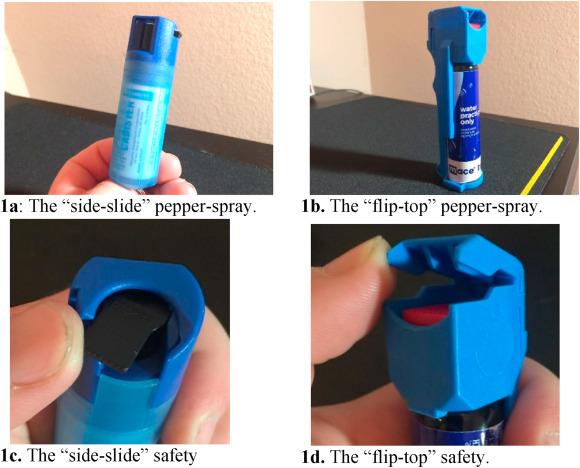Table of Contents
- Choosing the Right Gloves for Optimal Pepper Spray Use
- Techniques for Effective Pepper Spray Deployment in Cold Weather
- Preventing Cross-Contamination While Wearing Gloves
- Maintaining and Storing Pepper Spray Safely in Low Temperatures
- Wrapping Up
Choosing the Right Gloves for Optimal Pepper Spray Use
When it comes to enhancing your safety with pepper spray, selecting gloves that complement its use is essential. The ideal gloves should offer a precise balance between protection and dexterity. Look for gloves made of materials like nitrile or thin leather, which provide resistance against the spray’s residue but still allow you to maintain a firm grip on the canister. Bulky winter gloves might keep you warm, but they can hinder your ability to deploy pepper spray quickly and accurately in an emergency.
Consider these key factors when choosing gloves for pepper spray use:
- Material: Resistant to chemicals and easy to clean.
- Fit: Snug enough to avoid slipping but flexible enough for quick action.
- Grip: Textured surfaces help prevent the canister from slipping.
- Durability: Able to withstand repeated use without degrading.
Ultimately, testing your chosen gloves in a controlled setting can build confidence and ensure you are ready to use your pepper spray safely and effectively when it really counts.
Techniques for Effective Pepper Spray Deployment in Cold Weather
When temperatures drop, pepper spray users must adapt their techniques to maintain effectiveness. Cold weather can cause gloves to become stiff and bulky, making it challenging to grip and operate the spray confidently. To counter this, prioritize gloves that allow for dexterity and tactile sensitivity, such as thin, insulated gloves with touchscreen capabilities. This ensures you can quickly access and deploy your pepper spray without fumbling. Additionally, keep your pepper spray canister close to your body to prevent it from freezing or becoming less effective due to extreme chill.
Another critical factor is understanding how cold air affects the spray’s dispersal pattern. Windy and frigid conditions can cause the spray to drift unpredictably, reducing its impact or even blowing it back towards you. To maximize your safety:
- Position yourself upwind to avoid self-contamination.
- Deploy shorter bursts to conserve spray and maintain control.
- Practice deploying with gloves on beforehand to develop muscle memory and confidence.
By staying aware of these factors and adjusting your handling techniques, you’ll ensure that your pepper spray remains a reliable defense tool, even when the mercury drops.
Preventing Cross-Contamination While Wearing Gloves
Wearing gloves while handling pepper spray might seem like a straightforward barrier, but it requires mindful practices to avoid unintended contamination. Always use disposable gloves and change them frequently, especially if your gloves come into contact with different surfaces or your equipment. Avoid touching your face, phone, or other personal items until you’ve safely removed and discarded your gloves. This simple habit limits transfer of spray residue or any contaminants trapped on the glove surface.
When removing gloves, do so carefully by peeling them away from your wrist without touching the exterior. Place used gloves in a secure, sealed bag before disposing of them properly. Additionally, keep a supply of glove-safe sanitizing wipes handy to clean your hands right after removal. Incorporate these steps into your routine to maintain hygiene and ensure that your protective gear serves its purpose without compromising your safety or the effectiveness of your pepper spray.
- Use fresh gloves before each spray training or real use
- Dispose gloves immediately after exposure to pepper spray
- Sanitize hands after glove removal
- Avoid touching your face or other surfaces while gloved
Maintaining and Storing Pepper Spray Safely in Low Temperatures
When dealing with cold weather, it’s crucial to understand how low temperatures can affect your pepper spray’s performance and reliability. Exposure to freezing conditions can cause the propellant inside the canister to expand or contract, potentially leading to malfunction or even leakage. To avoid this, always store your pepper spray in a warm, insulated area whenever possible-such as inside your coat pocket against your body or within a glove compartment protected from frost. Avoid leaving it in unheated vehicles or exposed outdoor storage for extended periods, as the extreme cold may compromise the pressure and spray distance.
Proper maintenance during colder months also means periodically checking the canister for any signs of damage or wear. Here are some quick tips to ensure your pepper spray remains effective in cold weather:
- Keep it insulated: Use protective sleeves or cases designed to retain warmth.
- Regular testing: Conduct a brief test spray in a safe environment to confirm functionality.
- Avoid prolonged exposure: Limit the time your canister spends outdoors in freezing temperatures.
- Replace older units: Cold weather can exacerbate wear; ensure your spray is within its recommended expiry date.
By following these simple precautions, you can trust your pepper spray to perform effectively and remain safe to use-even in the chilliest conditions.
Wrapping Up
In conclusion, using pepper spray effectively and safely requires thoughtful preparation-especially when wearing gloves or facing cold weather conditions. By selecting the right type of gloves, practicing proper spray techniques, and understanding how cold temperatures affect your pepper spray, you can ensure your personal safety without compromising performance. Remember, regular practice and maintenance are key to staying confident and protected in any environment. Stay prepared, stay safe, and never underestimate the importance of adapting your self-defense tools to the conditions you might face.Check Our Other Blogs
- StunGun – Your Trusted Source for Stun Guns, Laws, and Self-Defense Tips
- PepperSprayLaws – Your Trusted Resource for Pepper Spray Information
- StunGunLaws – Your Trusted Guide to Stun Gun Legality and Safety




